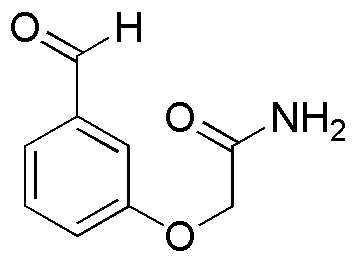2-(3-Formylphenoxy)acetamide is widely utilized in research focused on:
- Pharmaceutical Development: This compound serves as a key intermediate in the synthesis of various pharmaceuticals, particularly in the development of anti-inflammatory and analgesic drugs.
- Biochemical Research: It is used in studies investigating enzyme inhibition and protein interactions, aiding researchers in understanding cellular processes and disease mechanisms.
- Material Science: The compound can be incorporated into polymers to enhance their thermal stability and mechanical properties, making it valuable in the production of advanced materials.
- Agricultural Chemistry: It has potential applications in developing agrochemicals, such as herbicides or fungicides, contributing to more effective crop protection strategies.
- Analytical Chemistry: This chemical is employed as a reagent in various analytical techniques, helping in the detection and quantification of other compounds in complex mixtures.
General Information
Properties
Safety and Regulations
Applications
2-(3-Formylphenoxy)acetamide is widely utilized in research focused on:
- Pharmaceutical Development: This compound serves as a key intermediate in the synthesis of various pharmaceuticals, particularly in the development of anti-inflammatory and analgesic drugs.
- Biochemical Research: It is used in studies investigating enzyme inhibition and protein interactions, aiding researchers in understanding cellular processes and disease mechanisms.
- Material Science: The compound can be incorporated into polymers to enhance their thermal stability and mechanical properties, making it valuable in the production of advanced materials.
- Agricultural Chemistry: It has potential applications in developing agrochemicals, such as herbicides or fungicides, contributing to more effective crop protection strategies.
- Analytical Chemistry: This chemical is employed as a reagent in various analytical techniques, helping in the detection and quantification of other compounds in complex mixtures.
Documents
Safety Data Sheets (SDS)
The SDS provides comprehensive safety information on handling, storage, and disposal of the product.
Product Specification (PS)
The PS provides a comprehensive breakdown of the product’s properties, including chemical composition, physical state, purity, and storage requirements. It also details acceptable quality ranges and the product's intended applications.
Certificates of Analysis (COA)
Search for Certificates of Analysis (COA) by entering the products Lot Number. Lot and Batch Numbers can be found on a product’s label following the words ‘Lot’ or ‘Batch’.
Número de catálogo
Número de lote/lote
Certificates Of Origin (COO)
This COO confirms the country where the product was manufactured, and also details the materials and components used in it and whether it is derived from natural, synthetic, or other specific sources. This certificate may be required for customs, trade, and regulatory compliance.
Número de catálogo
Número de lote/lote
Safety Data Sheets (SDS)
The SDS provides comprehensive safety information on handling, storage, and disposal of the product.
DownloadProduct Specification (PS)
The PS provides a comprehensive breakdown of the product’s properties, including chemical composition, physical state, purity, and storage requirements. It also details acceptable quality ranges and the product's intended applications.
DownloadCertificates of Analysis (COA)
Search for Certificates of Analysis (COA) by entering the products Lot Number. Lot and Batch Numbers can be found on a product’s label following the words ‘Lot’ or ‘Batch’.
Número de catálogo
Número de lote/lote
Certificates Of Origin (COO)
This COO confirms the country where the product was manufactured, and also details the materials and components used in it and whether it is derived from natural, synthetic, or other specific sources. This certificate may be required for customs, trade, and regulatory compliance.


